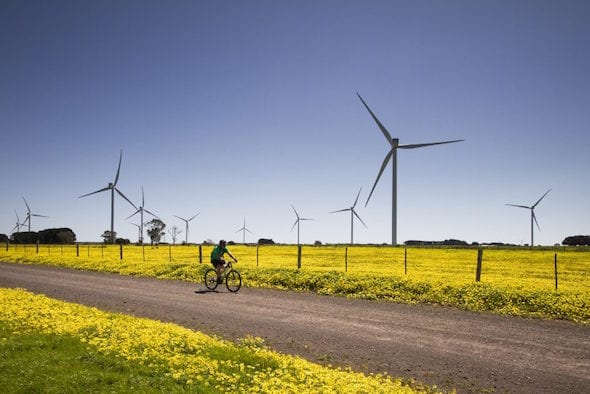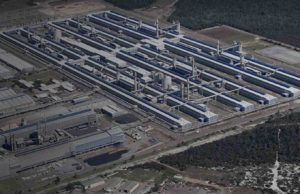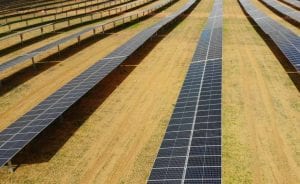Australia’s abundant wind and solar resources will deliver cost reductions in electricity of up to 30 per cent, lead to the electrification of much of transport, building and industrial use, and re-position Australia as major manufacturing centre with low cost and this time low carbon power.
This is the assessment of global advisory group McKinsey and Co, presenting at the Australian Energy Week conference in Melbourne, who note that the “all-in” cost of wind and solar in Australia – including firming, transmission and flexibility – is already cheaper than gas, and by 2030 the “all-in cost” of wind and solar will also be cheaper than all existing coal.
According to McKinsey’s New York-based senior partner Humayun Tai, who works with utilities and governments across the globe, the low cost of wind and solar will lead to an “electrification” of Australia’s energy system, meaning that wind and solar will not just displace coal and a lot of gas in the grid, it will also replace oil and gas in transport, heating and in industry.
Tai, who spoke to RenewEconomy before the conference, says the opportunity from low cost and low carbon electricity will be so great that it will offer an opportunity for Australia to regain a competitive advantage in key manufacturing sectors, including steel, aluminium.

To get there, however, will require significant investment, and a detailed and coherent long term plan.
If Australia is to take advantage of its low cost wind and solar resources, and use that cheaper electricity grid for more than 60 per cent of its total energy needs, about 5GW of wind and solar will need to be added to the grid each year. The grid will more than treble in size, and wind and solar will provide the overwhelming majority of generation.
To put this rate of deployment into context, it is about the same rate as the surge in wind and solar over the last two years as large scale players scramble to meet the renewable energy target, and households and businesses continue to add rooftop solar.
“The cost of renewable electricity generation will drop significantly over the next 15 years – even when you include the need for investment in new transmission and storage on the grid to manage the intermittency of renewable sources, the cost of energy they deliver will be lower than coal or gas generation,” Tai says.
“Given the lower cost advantage of renewables, we believe there will be a significant shift towards renewable sources in Australian electricity generation mix. It is possible to envisage a future where more than 60 per cent Australia’s energy could be delivered by electricity or hydrogen by 2050.
“Electrification of energy is an economic and scalable way to de-carbonise, for a competitive and clean Australia. And this may result in Australia being able to attract energy intensive industries (such as aluminium smelting and manufacturing) that see low electricity costs as giving them a competitive edge.”
Of course, McKinsey is not the only group highlighting the opportunities of cheap wind and solar, not just to lower electricity costs and emissions over the short to medium term, but also to re-boot the Australian economy, both for domestic manufacturing and renewable hydrogen exports over the medium to long term.
The likes of Professor Ross Garnaut, chief scientist Alan Finkel, and the Clean Energy Finance Corp and the Australian Renewable Energy Agency have pointed to the same possibilities. As have Labor and the Greens, and any number of other analysts.
Corporates are also starting to move in that direction. CWP and Macquarie have teamed with Vestas to advance the massive 11GW of wind and solar for the Pilbara, delivering cheap electricity to local manufacturing and for potential exports.
Sanjeev Gupta sees cheap renewables as the means to revive, decarbonise and expand Australia’s struggling heavy industry, particularly in steel and aluminium, while the likes of Sun Metals are turning to solar to lower costs and underpin the expansion of its zinc refinery, and provide more jobs, in Townsville.
 This graph above highlights the extent of electrification. By 2050, McKinsey suggests, nearly all light vehicle traffic will be electric, and half of all “medium” sized transport. Electricity will displace gas is most homes and nearly all businesses, and will also provide the bulk of heating needs in industry.
This graph above highlights the extent of electrification. By 2050, McKinsey suggests, nearly all light vehicle traffic will be electric, and half of all “medium” sized transport. Electricity will displace gas is most homes and nearly all businesses, and will also provide the bulk of heating needs in industry.
Tai says, however, that capturing these opportunities will require some fundamental changes in the way Australia invests in and manages its electricity grid infrastructure.
It will invest in new transmission to connect areas with favourable renewable energy resources to the grid, and invest in short and long-term storage options to manage intermittency of renewables.
It will need to modernise power grid distribution infrastructure to manage distributed generation, look at market design and ensure the right market mechanisms are in place to minimise system cost and maintain consistency, and address areas of uncertainty that may prevent key players from making the investments required to enable this future vision.
There is no indication at all that the federal government is ready to discuss any of these issues, but the Australian Energy Market Operator is advancing some of the grid infrastructure needs through its Integrated System Plan, while the Energy Security Board is looking at a long-term rethink of the market rules.

Tai says the fact that Australia currently has a very large coal based system makes the debate – at least about economics and infrastructure – easier than other countries where nuclear looms as a low-carbon, but hugely expensive and complex alternative.
“Here (in Australia) it is a discussion between coal and renewables. In some ways that helps to simplify the discussion,” Tai says (ED: if not the politics).
Tai also notes Australia’s leadership in distributed solar, particularly in Western Australia, which is a relatively large but isolated grid that is grappling with a rapid increase in rooftop solar. Tai says W.A. is unique, possibly matched only by Hawaii, and the lessons learned will be applicable to other parts of the world.








